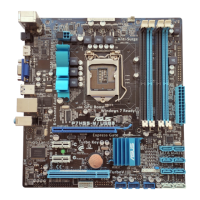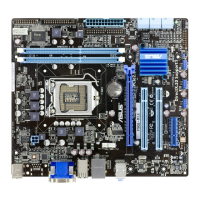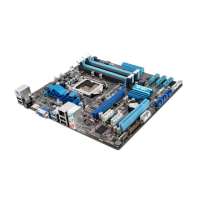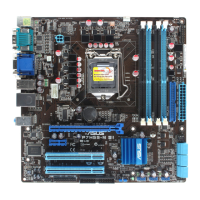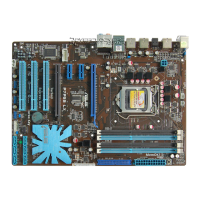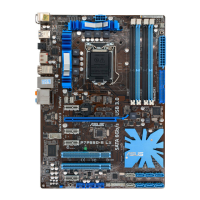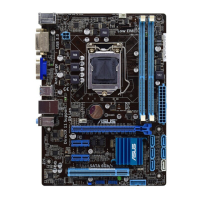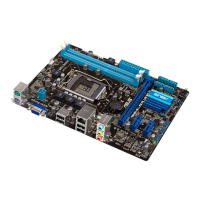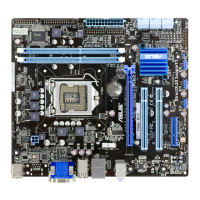
Do you have a question about the Asus P7H55-M LX USB3 and is the answer not in the manual?
| CPU Socket Type | LGA 1156 |
|---|---|
| Chipset | Intel H55 |
| PCI Express 2.0 x16 | 1 |
| PCI Express x1 | 2 |
| USB 3.0 | 2 |
| LAN Chipset | Realtek 8112L |
| Max. LAN Speed | 10/100/1000Mbps |
| Form Factor | Micro ATX |
| RAID Support | No |
| Multi-GPU Support | No |
| Memory Standard | DDR3 1333/1066 |
| Audio Channels | 8 |
| Video Outputs | DVI-D |
| USB Ports | 8 x USB 2.0 ports (4 at back panel, 4 at mid-board) 2 x USB 3.0 ports (at back panel) |
FCC compliance details for digital devices and radio frequency energy.
Statement regarding radio noise emission limits for digital apparatus.
Information on compliance with REACH regulations for chemicals.
Covers electrical and operational safety precautions for the motherboard.
Explains the structure and content of the user guide.
Explains symbols and text formatting used throughout the manual.
Lists resources for additional product and software information.
Details about the supported Intel processors and socket type.
Information on the Intel H55 Express Chipset.
Details on dual-channel DDR3 memory support and limitations.
Lists the available PCI and PCI Express slots.
Lists all external connectors on the motherboard's rear panel.
Details internal headers and connectors on the motherboard.
Specifies the motherboard's physical dimensions.
Important precautions before installing components or changing settings.
Explains the function of the system standby power LED.
Visual guide to the physical arrangement of components on the motherboard.
Identifies and locates various connectors, jumpers, and LEDs.
Details about the LGA1156 socket and processor compatibility.
Introduction to the motherboard's DDR3 DIMM sockets.
Details on installing and configuring DDR3 DIMMs.
Qualified Vendors List (QVL) for DDR3-1333MHz memory.
Qualified Vendors List (QVL) for DDR3-1066MHz memory.
Step-by-step guide to installing expansion cards.
Steps to configure installed expansion cards via BIOS and drivers.
Information on PCI and PCI Express slot types and capabilities.
How to clear CMOS memory using the CLRTC jumper.
Detailed description of all ports on the motherboard's rear panel.
Introduction to the various internal connectors on the motherboard.
Information on SATA connectors and the digital audio connector.
Details on fan, system panel, and ATX power connectors.
Connecting front panel audio modules and the system speaker.
Guidance on installing OS and drivers for compatibility.
Overview of drivers and utilities included on the support DVD.
How to manage, save, and update the motherboard BIOS.
Details on using the ASUS Update utility for BIOS management in Windows.
Instructions for updating BIOS using EZ Flash 2 utility in BIOS.
How to update BIOS in DOS environment using ASUS BIOS Updater.
Utility for recovering corrupted BIOS files.
Methods to access the BIOS Setup utility at startup or after POST.
Overview of system information displayed in the Main BIOS menu.
Settings related to CPU features, performance, and power management.
Advanced chipset settings, DRAM frequency, and graphics adapter selection.
Enabling/disabling onboard devices like HDA Controller and LAN.
Settings for USB functions, legacy support, and mass storage devices.
Configuration of ACPI sleep states (S1, S3, Auto).
Settings for power management features like Restore on AC Power Loss.
Monitoring of system temperatures, fan speeds, and voltages.
Setting the sequence of devices for system startup.
Options for Quick Boot and Full Screen Logo display.
Setting Supervisor and User passwords for system access.
Options to save/discard changes, load defaults, or exit the BIOS.
Compatibility guide for LGA1156 processors and chipsets.
Instructions for configuring memory based on CPU and DIMM count.
Details on PCIe x16 slot usage with different CPUs.
Contact details for ASUS headquarters in Taiwan.
Contact information for ASUS North America support.
Contact details for ASUS support in Germany and Austria.
Statement of compliance with FCC Part 15 rules.
Compliance with European Union directives (EMC, R&TTE, LVD, ErP).
